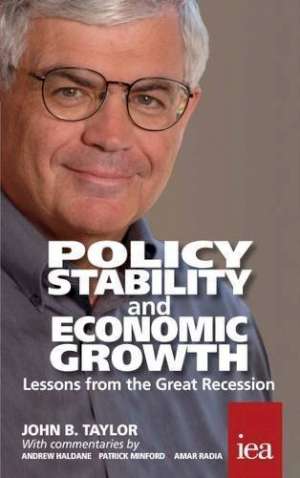28 June 2016
Policy Stability and Economic Growth - Lessons from the Great Recession
John Taylor
2016, IEA, 112 pages,
Reviewer: Vicky Pryce, Former Joint Head of the Government Economic Service

The exact causes of the financial crisis of 2008 are still being debated. But, caught unawares, the policy establishment reacted by slashing interest rates while at the same time embarking on a process of re-regulating the banks and gradually introducing new requirements by central banks, adding financial and macro-prudential instruments to their panoply of interventions. The question is the extent to which this new policy system, departing from clear simple monetary rules and allowing policy discretion, may in fact have ended up being too confusing, at times contradictory and sending mixed messages to market participants – and thus inhibiting growth. That seems to be the message of the IEA’s 2015 Hayek lecture given by John Taylor, Professor at Stanford and inventor of the Taylor rule.
His rule is aimed at price stability and links interest rate policy directly to the deviation of the current inflation rate from target, with an adjustment also for the output gap relative to trend. In the long term the equilibrium interest rate is assumed at around 2%. The rule has been extremely useful in defining the monetary policy framework around the world but it has not always been followed to the letter, especially in the years preceding and following the financial crisis.
Indeed in this lecture John Taylor places some of the blame for the failure of the system on the departure from a rules-based framework by central bankers, most importantly by the US Federal Reserve in the early 2000s. And the continued use of discretion exercised since has, in his view, taken away policy certainty, negatively affected investment and increased the chances of financial bubbles re-emerging.
Professor Patrick Minford, in a response published in this volume, agrees that the Taylor rule is important but on its own would probably not have prevented the financial crisis. He argues that inflation may well stay near target even at a time of rapid liquidity build-up in the financial sector and will not vary enough to prompt the type of monetary responses needed to prevent credit booms and busts. And that the rule itself, once introduced, affects behaviour and distorts its impact; just as once inflation targeting is taken seriously and believed, it tends to anchor inflationary expectations around the 2% target level and lull policymakers into a false sense of comfort. Alternative targets linked to other variables such as nominal GDP might allow better and faster responses to excessive monetary expansion and liquidity bubbles.
Andy Haldane, Chief Economist at the Bank of England, and his colleague Amar Radia have also written interesting response to the lecture. In their view, the Taylor rule alone if adhered to the letter would have required considerably higher interest rates before the crisis (affecting output and employment), and much lower ones since. The output gap itself would have been wrongly estimated as much larger than it ended up being. And what’s more there is increased focus now on rethinking the appropriate equilibrium interest rate in radically changed global circumstances. Therefore ‘judgement’ in interest rate setting makes sense, they argue, and monetary policy can be more effective if accompanied by other measures such as macro-prudential policy rules and financial stability responses to adjust any unwelcome responses to the new era of (for the moment at least) record low interest rates.
